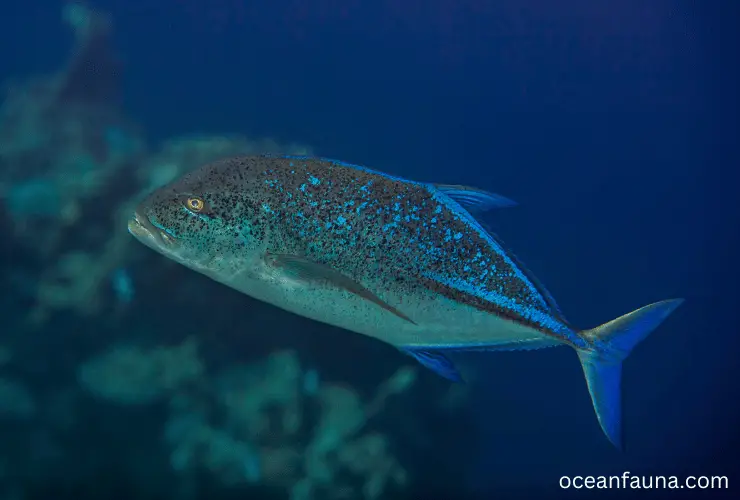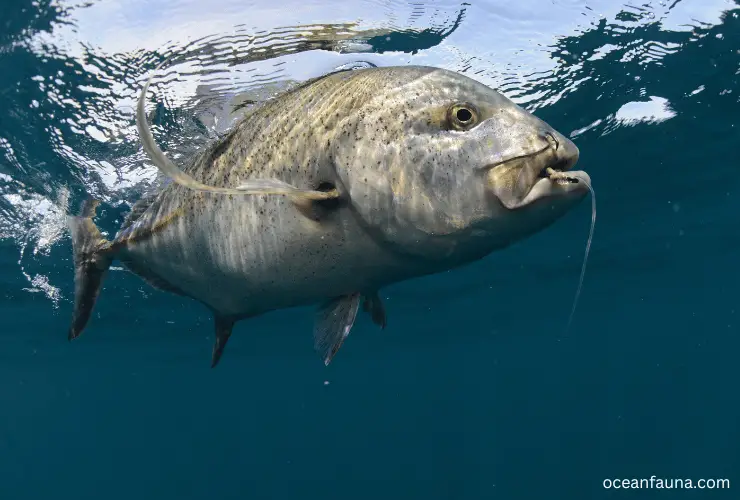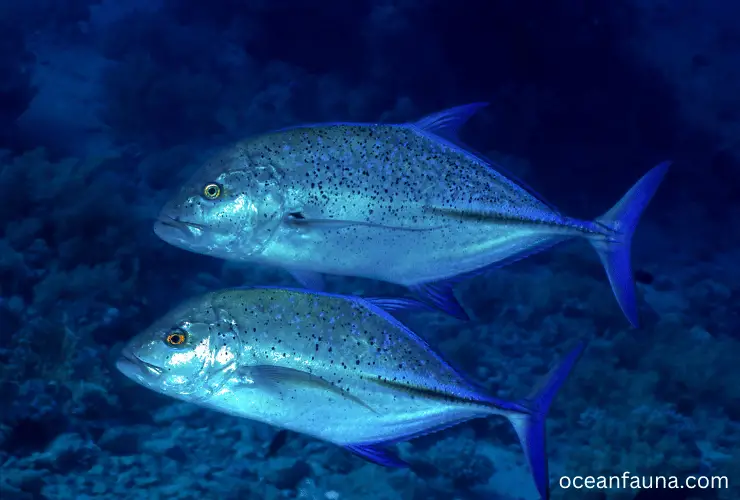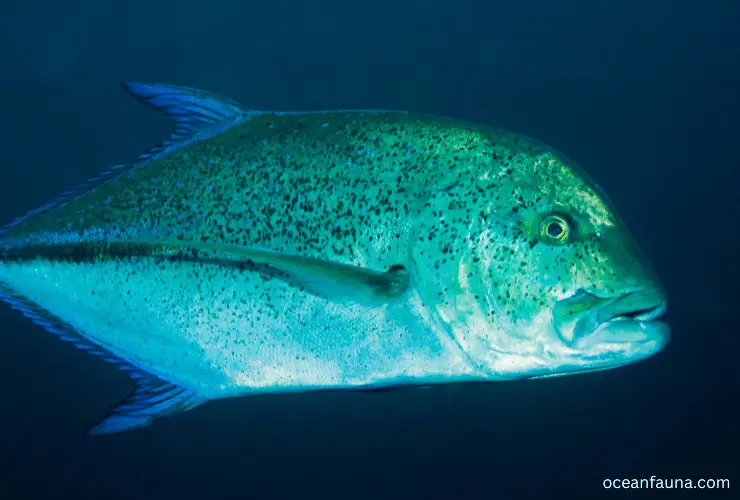Bluefin trevally is scientifically known as Caranx melampygus. They are also called blue-finned crevalle, omilu, bluefin kingfish, spotted trevally, blue Ulua, and bluefin jack. Thus, it has many common names, and its bibliographical facts are also known. These are large species of marine fish.
Bluefin trevally can be found in various marine habitats throughout the world. These are the members of the Carangidae family. These are powerful fish that are known for their impressive size. Also, they are known as a popular fish among fishermen and a sought-after delicacy in many cultures.
Are you a fan of the ocean and all its mysteries? Have you ever wondered about the creatures that lurk beneath the surface? If so, then you’re in for a treat. In this article, we’ll be exploring the bluefin trevally. These are the powerful predator that calls the ocean their home. So, grab a cup of coffee, sit back, and dive into the world of the bluefin trevally together!

About Bluefin Trevally – A Quick Biology Table
Here’s a quick biology table outlining some key features and bibliographical facts of the valley’s bluefin.
| Parameters | Details |
| Scientific name | Caranx melampygus (G. Cuvier, 1833) |
| Kingdom | Animalia |
| Family | Carangidae |
| Genus | Caranx |
| Class | Actinopterygii |
| Order | Carangiformes |
| Phylum | Chordata |
| Species | C. melampygus |
| Habitat and geographical range | Rocky Island, coastal waters of reefs, channels, and lagoons, peeks of outside reefs, depth waters |
| Diet | Small mackerel, anchovies, sardines, squid, crabs, shrimp |
| Predators | Humans, seals, sharks |
| Size | 3.8 feet (1.2 meters) |
| Weight | 43.5 kg |
| Lifespan | Up to or above 25 years |
Taxonomy and Phylogeny of the Bluefin Trevally
The genus of the bluefin trevally is Caranx. Caranx is one of the popularly known groups. These various groups are known as trevallies or jacks. Caranx belongs to the Carangidae family. This is a group of horse mackerels and jacks. This family is a famous part of the Carangiformes order.
Archive organization researchers have found the following facts:
“In 1833, the bluefin trevally was initially identified by the celebrated French naturalist Georges Cuvier. He based his scientific description on some samples taken off Waigeo, Indonesia, from which one was assigned to be the holotype.
Cuvier named the bluefin trevally species as Caranx melampygus. He assigned it to the Caranx jack genus that had been set up by Bernard Lacépède 30 years prior. The specific term of its name originates from the Latin interpretation of “black spotted.” ~ source
According to the California Academy of Sciences, they had placed the bluefin trevally in other genera such as Carangus and Carangichthys. It is still considered correctly placed in the jack genus Caranx as per the original classification by Georges Cuvier in 1833. These other classifications have since been deemed incorrect.
Seven different names were given to the bluefin trevally after its initial description by Cuvier. These were named and described between 1836 and 1895. These names were assigned independently, but the species is still recognized as the one described by Cuvier.
The taxonomic history of the bluefin trevally has been fraught with confusion. Several names were assigned to the species in the past. Some of these names, such as C. bixanthopterus and C. stellatus, were later classified as either synonyms or separate species. However, in 1965, Frederick Berry revised the taxonomy of the species.
He resolved these names as being synonymous with C. melampygus. According to ICZN nomenclature rules, these later names are now considered junior synonyms of C. melampygus. Moreover, these are rendered invalid. The bluefin trevally is now recognized as a single species belonging to the jack genus Caranx even after taxonomic confusion.
Physical Characteristics / Anatomy of the Bluefin Trevally

The first and foremost characteristic that needs to be considered is that these are counted as large fish of water. Here are a few physical characteristics of bluefin trevally:
| Parameters | Details |
| Maximum length | 46 inches (117 centimeters) |
| Maximum weight | 96 lb (43.5 kilograms) |
| Color | Dark blue-black on the back and upper sides, fading to silver on the lower sides and belly |
| Shape | Streamlined and fusiform, with a deeply forked tail |
| Fins | Two dorsal fins, the first with 8 spines and the second with 1 spine and 18-20 soft rays; anal fin with 2 spines and 15-18 soft rays |
| Scales | Covered in small, smooth scales |
| Eyes | Large and set high on the head, with a golden iris |
| Mouth | Terminal mouth with sharp teeth |
| Lateral line | Prominent lateral line running down the length of the body |
According to Internet Archive’s organization, bluefin trevally is rare where their lengths are more than 31 in (80 centimeters). The striking electric blue fins, tapered snout, and distinctive blue and black spotting make it easy to spot in the ocean. ~ source
Identifying juvenile bluefin trevally can be challenging as they lack the striking colors of adults. They require a closer examination of their anatomical features. These may include scute counts and fin rays.
Behaviors of the Bluefin Trevally
Here are a few behaviors of the bluefin trevally that will amaze you:
Spawning aggregation behavior
The bluefin trevally is known to form spawning aggregations. In this process, large numbers of individuals gather in specific locations to reproduce.
These aggregations can be an important target for commercial and recreational fishing. Overfishing of these aggregations can have significant impacts on bluefin trevally populations.
Migratory behaviors
The bluefin trevally exhibits a degree of migratory behavior. They move between different habitats depending on the availability of food and breeding opportunities. The timing and distance of these migrations can vary.
It depends on environmental factors such as water temperature, currents, and food availability. Overall, the migratory behavior of bluefin trevally is an important aspect of their ecology and survival.
Feeding Habits/Diet of the Bluefin Trevally
Bluefin trevally is known as a fish with strong predatory behaviors. They predominantly eat fish and invertebrates. The adults love to eat crustaceans and cephalopods. This is their supplemental diet. Now, what do juveniles eat?
Juveniles eat smaller crustaceans. They consume a small amount of food. These little guys shift their diet to fish-based items when they start growing. Moreover, these species of fish have a wide variety of hunting techniques. Let’s see a few of them below. ~ source
But, before reading about its remarkable hunting techniques, let’s go through its diet table.
| Diet Type | Prey Items | Prey Species |
| Fish | Small fish | Anchovies, sardines, mullet, herring |
| Crustaceans | Crabs, shrimp, lobsters | Hermit crabs, ghost shrimp, spiny lobsters |
| Cephalopods | Squid, octopus, cuttlefish | Arrow squid, southern calamari, reef squid |
| Other Invertebrates | Snails, worms, sea urchins | Cone snails, bristle worms, long-spined sea urchins |
Aggressive Midwater Attacks of the Bluefin Trevally
Bluefin Trevally is known for its aggressive midwater attacks. They dart through the water and strike their prey with lightning-fast speed. They use their streamlined shape and powerful muscles to chase down their prey. They are often working together in schools to corral and capture fish.
Reef Ambushes
When hunting around reefs, the bluefin trevally uses its camouflage to blend in with its surroundings. They patiently wait for an opportunity to strike. They often hide behind rocks or coral formations.
After that, they suddenly darted out to capture unsuspecting prey. This ambush technique allows them to conserve energy while maximizing their chances of success.
Foraging Interactions with Other Larger Species
Bluefin Trevally is also known to forage in partnership with other larger species, such as sharks or rays. They snap up any prey items missed by the larger animal. It means they are taking advantage of their partner’s hunting prowess to secure an easy meal.
This behavior is known as kleptoparasitism. It allows them to maximize their feeding opportunities while minimizing their own energy expenditure.

Habitat, Range, and Distribution of the Bluefin Trevally
Although bluefin trevally can be found all over the world, they typically inhabit tropical waters. One of the many places where these are inhabited is the Indian Ocean and the Pacific Ocean. They range from Eastern Central America to Western Eastern America. This range may also include southern Australia and northern Japan.
Here is a comprehensive table that lists all of the locations where this bluefin trevally is found:
| Continents | Locations / States / Countries | Oceans/Seas/Islands | Habitat | Range |
| Africa | The southern tip of South Africa | Indian Ocean | Coastal waters, coral reefs | The southern tip of South Africa |
| East African coastline | Indian Ocean | Coastal waters, coral reefs | North along the east African coastline, Red Sea, Persian Gulf | |
| Asia | Pakistan | Arabian Sea, Indian Ocean | Coastal waters, coral reefs | Along the Asian coastline including Pakistan, India, and into Southeast Asia |
| Malaysia to Vietnam | Western Pacific, South China Sea | Coastal waters, coral reefs | Coastal areas from Malaysia to Vietnam and mainland China | |
| Hong Kong, Taiwan | Western Pacific | Coastal waters, coral reefs | The offshore range extends north to Hong Kong, Taiwan, and southern Japan | |
| Australia | Northern Australia, Exmouth Gulf, Sydney | Indian Ocean, Pacific Ocean, Cocos (Keeling) Islands | Coastal waters, coral reefs, and offshore islands | Northern Australia, the southernmost record from the west coast of Australia comes from Exmouth Gulf and reaches as far south as Sydney |
| Oceania | Solomon Islands, Tonga, Western Samoa, Polynesia, Hawaiian Islands | Pacific Ocean | Offshore islands, coral reefs | Abundant in the central Indo-Pacific region, found throughout all the archipelagos and offshore islands including Indonesia, the Philippines, Solomon Islands, Tonga, Western Samoa, Polynesia, and the Hawaiian Islands |
| South America | The Mesoamerican coastline between Mexico and Ecuador | Eastern Pacific, Galápagos Islands | Coastal waters, coral reefs | The easternmost limit of the species distribution is the Mesoamerican coastline between Mexico and Ecuador in the central-eastern Pacific, including islands such as the Galápagos Islands. |
| Seychelles | Indian Ocean | Coastal waters, coral reefs | Recorded from small island groups including Seychelles | |
| Madagascar | Indian Ocean | Coastal waters, coral reefs | Reported from various island groups including Madagascar |
According to NOAA FishBull, bluefin trevally are versatile. They can be found in a variety of marine habitats. They can be seen from lagoons and shallow bays to deeper offshore reefs, bomboras, seagrass meadows, sand flats, and atolls.
In some locations, juvenile bluefin can be found trevally in estuaries and other protected, shallow waters. On the other hand, adults tend to prefer deeper offshore environments. ~ source
Researchers from Cambridge University Press claim that juveniles and sub-adults prefer to live in water that is about 2 meters deep. On the other hand, adults prefer to live at depths of around 183 meters. ~ source
Moreover, Elsevier’s research has discussed an amazing fact about its habitat. The bluefin trevally exhibits distinct habitat segregation from the giant trevally, Caranx ignobilis. The latter is more prevalent within the major bays than the former.

Reproduction System of the Bluefin Trevally
Bluefin trevally reproduces through external fertilization. In this process, the male releases sperm into the water, and the female releases her eggs. This typically occurs in schools of several hundred individuals during the spawning season. This can vary depending on location and environmental factors.
During spawning, males and females engage in courtship behavior. This behavior includes chasing and swimming in circles around each other. The actual release of eggs and sperm usually occurs at night near the water’s surface. Once the eggs are fertilized, they hatch into larvae. The larvae then develop into juvenile fish.
Bluefin trevally reaches sexual maturity at around two to three years of age. They may also become mature when they reach a length of approximately 25-30 cm. However, the exact age of sexual maturity can vary depending on environmental conditions and population density.
Bluefin trevally is a polyestrous species. It means it can reproduce multiple times throughout the year. In fact, it can spawn up to eight times per year. It can release a large number of eggs each time. In captivity, a single female can release up to 6 million eggs or more per year.
This high reproductive potential is an adaptation to the species’ unpredictable environment. The timing and availability of food can fluctuate greatly. The growth rates of these marine fish have been extensively researched. ~ source
“The studies have shown that in the first year of life, they can reach a length of up to 194 mm. By the end of their second year, their length can increase to approximately 340 mm. They can reach a length of around 456 mm by the end of their third year.”
Thus, bluefin trevally has an interesting reproduction system.
Life Cycle and Lifespan of the Bluefin Trevally
Bluefin trevally has a complex life cycle. This includes an egg stage, a larval stage, a juvenile stage, and an adult stage. The complete reproduction cycle is given in the above section.
The lifespan of bluefin trevally is not precisely known. However, they are believed to live up to 24 years in the wild. Their lifespan can vary depending on factors such as habitat quality, food availability, and predation pressure.
Hazards to Bluefin Trevally
Bluefin trevally faces various hazards that threaten its population and survival. Here are some of the hazards that impact the species:
- Overfishing: Bluefin trevally is a popular fish species for commercial and recreational fishing. It can lead to overfishing and reduced populations.
- Habitat destruction: Coral reefs serve as nurseries and shelters for juvenile fish. Destruction of coral reefs, mangroves, and other coastal habitats can affect the species’ survival.
- Pollution: Water pollution from industrial waste, agricultural runoff, and plastic debris can impact the health of the bluefin trevally. These hazards also impact the prey they feed on.
- Climate change: Changes in water temperature, acidity, and other environmental factors are impactful. They can impact the bluefin trevally’s habitat, prey availability, and reproductive cycles.
It is important to understand and address these hazards to ensure the sustainable use of bluefin trevally populations.
Economic Importance of the Bluefin Trevally
Fishermen commonly pursue the bluefin trevally. Both recreational and commercial fishermen take advantage of these aquatic fish. Overfishing has caused a drastic decline in the bluefin trevally population in Hawaii. It is leading to a surge in research on its aquaculture potential.
As a result, the spawning of the species has been successfully achieved in captivity. More interestingly, bluefin trevally is a highly sought-after fish for consumption. However, numerous incidences of ciguatera poisoning have been linked to its consumption.
Statistics on the catch of the bluefin trevally are generally not well-documented, and only the FAO receives data from certain areas in the western Indian Ocean. The amount caught in this region has varied from 2 to 50 tons over the last ten years. Also, approximately 700 lbs are caught each year in Hawaii. ~ source
A concentrated effort has been made to breed the bluefin trevally in captivity due to the fast depletion of its population. Scientists in French Polynesia experimented in 1975 to examine the aquaculture potential of the bluefin trevally. Juvenile specimens of the species were captured from their wildlife.
They were then brought to a research facility, where they underwent analysis. According to the research, the fish could grow to a size of 30 grams, which is a standard commercial size for these fish. They reached this size in just 6 to 8 months.
More interestingly, the mortality rate was also low. It was only 5%. This experiment was beneficial for economic balance. Thus, bluefin is not just ecologically important but also economically beneficial for humans. ~ source
Predators of the Bluefin Trevally
There are a few predators of bluefin trevally fish due to their large size. Moreover, these fish species are strong fighters. Most of the predators hunt bluefin in its juvenile and adult stages. Some of their predators are given in the table below.
| Predators of Bluefin Trevally | Details |
| Large predatory fish | Bluefin trevally is preyed upon by larger predatory fish. Some of these fish include barracuda, groupers, sharks, and tuna. These fishes hunt bluefin trevally as part of their natural diet. |
| Marine mammals | Marine mammals such as dolphins and seals have been observed preying on bluefin trevally. These predators use their speed and agility to chase and capture the fish. |
| Birds | Some species of birds such as ospreys and pelicans also prey on bluefin trevally. These birds use their sharp beaks and talons to capture the fish from the surface of the water. |
| Humans | Humans are the biggest predators of bluefin trevally. These species of fish are popularly hunted by fishermen. Overfishing and destructive fishing practices have reduced the population of bluefin trevally in many areas. |
Conservation Status of Bluefin Trevally
The conservation status of the bluefin trevally is “Least Concern” according to the assessment of The IUCN Red List. These fish species are neither threatened, endangered or rare. However, these are widely distributed all over the world.
Their populations are currently considered stable. However, they are subject to various threats, like all the various marine species. These threats may include the following:
- Overfishing
- Habitat destruction
- Climate change
It is important to monitor their population status. It ensures that fishing practices are sustainable to ensure the long-term health of bluefin trevally populations.
Communication Method of Bluefin Trevally

It is said that little research work is done about the communication Method of bluefin trevally. They are known to use a combination of visual, auditory, and chemical signals for communication.
- Visual communication includes changes in body posture and coloration. This communication method is used to indicate aggression or submission.
- Auditory signals include popping sounds created by the fish’s swim bladder. This method may be used for communication during mating or territorial disputes.
- Chemical signals are also important for communication, especially in the context of finding mates or marking territory. The fish have scent glands on their bodies, and they release chemical signals to communicate with other fish. These chemical signals are commonly called pheromones.
FAQs
Are bluefin trevally poisonous?
Yes, the bluefin trevally can be poisonous. The bluefin trevally has been linked to incidents of ciguatera poisoning. This type of food poisoning results from the buildup of toxins produced by specific varieties of seaweed.
Examinations carried out in a laboratory have verified that the poison exists in the flesh of bluefin trevally. It is also probable that fish that exceed a length of 50 cm can be hosts of the toxin. The sales of fish in the marketplace have been impacted by the risk of poisoning in recent years.
What’s the speed of Bluefin trevally?
Bluefin Trevally is known to be a fast swimmer. They have an average swimming speed of around 35-40 km/h (22-25 mph).
Conclusion
After reading all about the bluefin trevally, we’ve come to the end of our journey. Whether you’re a fan of fishing or just interested in marine life, there’s always something new and exciting to discover. Who knows, maybe you’ll even encounter a bluefin trevally on your next beach vacation.
I hope you had as much fun as we did while exploring Bluefin Ulua!
